Objective 2. Use the Drawing Toolbar
The Drawing toolbar has tools to add text boxes, lines, arrows, boxes, circles, and predefined shapes to your document. Many of these drawing objects can be formatted; that is, you can increase line thickness and color, change font colors, and change background colors and patterns. A drawing canvas is provided as a work area for complex drawings; however, when inserting and formatting simple drawing objects, it is more convenient to turn the drawing canvas off.
Activity 3.5. Inserting a Text Box
A text box is a movable, resizable container for text or graphics. A text box is useful to give text a different orientation from other text in the document because a text box can be placed anywhere in the document, just like a floating image. A text box is a drawing object and, as such, can be placed outside the document margin, resized, and moved. This is easier if you first turn off the drawing canvas. As you progress in your study of Word, you will learn more about using the drawing canvas.
|
1. |
From the Tools menu, click Options, and then click the General tab. |
|
2. |
Under General options, locate the Automatically create drawing canvas when inserting AutoShapes check box and, if necessary, clearclick to remove the check markthe check box. Click OK to close the Options dialog box and turn off the drawing canvas. |
|
3. |
Check to see if the Drawing toolbar is displayed at the bottom of your screen. If it is not, on the Standard toolbar, click the Drawing button |
|
4. |
Position your document so the bulleted list is near the top of your screen. On the Drawing toolbar, click the Text Box button Figure 3.16. 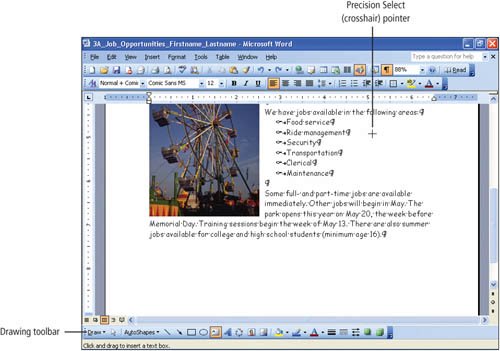
|
|
5. |
Position the |
|
6. |
Type The SuperSpeed Ferris Wheel, one of the new rides at Sensation! Park and then Save Figure 3.17.
|
Activity 3.6. Moving and Resizing a Text Box
|
1. |
Point to one of the borders of the text box until the Move pointer Figure 3.18. 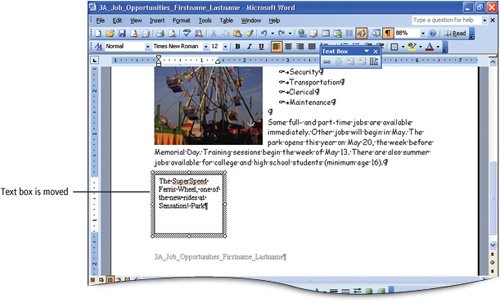
|
|
|
|
|
2. |
Scroll down until you can see the entire text box. If necessary, position the pointer over the center right sizing handle to display the Horizontal Resize pointer |
|
3. |
On the Formatting toolbar, click the Center button Figure 3.19. 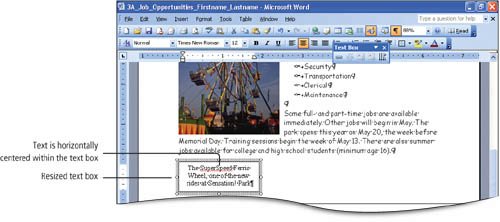
|
Activity 3.7. Inserting an Arrow
Buttons on the Drawing toolbar enable you to create shapescircles, boxes, lines, and arrows. Arrows are useful to point out features in graphic objects such as photographs and maps.
|
1. |
Reposition the Ferris wheel as necessary so the text wraps as shown in Figure 3.20. On the Drawing toolbar, click the Arrow button Figure 3.20. (This item is displayed on page 424 in the print version) 
Alert!: Does a Large Drawing Box Display? If you did not deactivate the drawing canvas, clicking buttons on the Drawing toolbar activates the drawing canvasa work area for creating drawings. This work area is useful for combining several graphic objects, but gets in the way when you want to add simple shapes to a document. To turn off the drawing canvas, click the Close button on the Drawing Canvas toolbar and click in the drawing canvas area. To deactivate the drawing canvas, from the Tools menu, click Options, click the General tab, and then clear the Automatically create drawing canvas when inserting AutoShapes check box. |
|
|
|
|
2. |
Position the NoteDrawing a Horizontal or Vertical Line If you want to draw an arrow or line that is perfectly horizontal or vertical, hold down |
|
3. |
Move the pointer over the selected arrow and right-click. From the shortcut menu, click Format AutoShape, and then in the displayed Format AutoShape dialog box, click the Colors and Lines tab. |
|
4. |
Under Line, click the Weight spin box up arrow three times to select 1.5 pt. Under Arrows, click the End size arrow, and then from the displayed menu, click the largest arrowheadArrow R Size 9. |
|
5. |
In the Format AutoShape dialog box, click the Layout tab. Under Wrapping style, click Tight. |
|
6. |
Click OK to increase the line thickness and arrowhead size and move the text away from the arrow. Compare your dialog box with Figure 3.21. Save Figure 3.21. 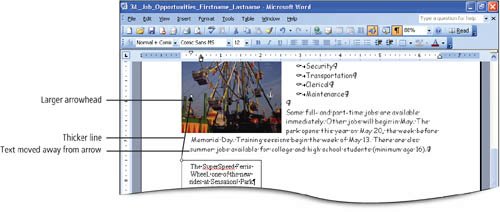
|
Activity 3.8. Inserting an AutoShape
AutoShapes are predefined drawing shapessuch as stars, banners, arrows, and calloutsthat can be inserted in a document. More than 150 predefined AutoShapes are available with Word.
|
1. |
On the Drawing toolbar, click the AutoShapes button Figure 3.22. 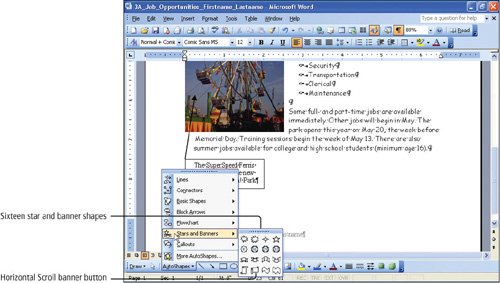
|
|
|
|
|
2. |
In the fourth row of the Stars and Banners menu, click the second shapethe Horizontal Scroll banner button |
|
3. |
Position the Figure 3.23. 
|
|
4. |
Move the pointer over the banner and right-click. From the shortcut menu, click Add Text. |
|
5. |
Type Call 215.555.1776 and then select the text you just typed. From the Formatting toolbar, change the Font Size to 28, apply Bold |
|
6. |
With the banner still selected, on the Drawing toolbar, click the Fill Color arrow Figure 3.24. 
|
|
7. |
Save |
|
8. |
On the Print Preview toolbar, click the Print button |
|
9. |
Close your document, saving any changes. From the View menu, point to Toolbars, and then click Drawing to turn off the display of the Drawing toolbar. Close Word. |
|
End |
You have completed Project 3A |
Project 3B Park Changes |
Windows XP
- Chapter One. Getting Started with Windows XP
- Project 1A. Windows XP
- Objective 1. Get Started with Windows XP
- Objective 2. Resize, Move, and Scroll Windows
- Objective 3. Maximize, Restore, Minimize, and Close a Window
- Objective 4. Create a New Folder
- Objective 5. Copy, Move, Rename, and Delete Files
- Objective 6. Find Files and Folders
- Objective 7. Compress Files
- Summary
- Key Terms
- Concepts Assessments
Outlook 2003
- Chapter One. Getting Started with Outlook 2003
- Getting Started with Microsoft Office Outlook 2003
- Project 1A. Exploring Outlook 2003
- Objective 1. Start and Navigate Outlook
- Objective 2. Read and Respond to E-mail
- Objective 3. Store Contact and Task Information
- Objective 4. Work with the Calendar
- Objective 5. Delete Outlook Information and Close Outlook
- Summary
- Key Terms
- Concepts Assessments
- Skill Assessments
- Performance Assessments
- Mastery Assessments
- Problem Solving
- GO! with Help
Internet Explorer
- Chapter One. Getting Started with Internet Explorer
- Getting Started with Internet Explorer 6.0
- Project 1A. College and Career Information
- Objective 1. Start Internet Explorer and Identify Screen Elements
- Objective 2. Navigate the Internet
- Objective 3. Create and Manage Favorites
- Objective 4. Search the Internet
- Objective 5. Save and Print Web Pages
- Summary
- Key Terms
- Concepts Assessments
- Skill Assessments
- Performance Assessments
- Mastery Assessments
- Problem Solving
Computer Concepts
- Chapter One. Basic Computer Concepts
- Objective 1. Define Computer and Identify the Four Basic Computing Functions
- Objective 2. Identify the Different Types of Computers
- Objective 3. Describe Hardware Devices and Their Uses
- Objective 4. Identify Types of Software and Their Uses
- Objective 5. Describe Networks and Define Network Terms
- Objective 6. Identify Safe Computing Practices
- Summary
- In this Chapter You Learned How to
- Key Terms
- Concepts Assessments
Word 2003
Chapter One. Creating Documents with Microsoft Word 2003
- Chapter One. Creating Documents with Microsoft Word 2003
- Getting Started with Microsoft Office Word 2003
- Project 1A. Thank You Letter
- Objective 1. Create and Save a New Document
- Objective 2. Edit Text
- Objective 3. Select, Delete, and Format Text
- Objective 4. Create Footers and Print Documents
- Project 1B. Party Themes
- Objective 5. Navigate the Word Window
- Objective 6. Add a Graphic to a Document
- Objective 7. Use the Spelling and Grammar Checker
- Objective 8. Preview and Print Documents, Close a Document, and Close Word
- Objective 9. Use the Microsoft Help System
- Summary
- Key Terms
- Concepts Assessments
- Skill Assessments
- Performance Assessments
- Mastery Assessments
- Problem Solving
- You and GO!
- Business Running Case
- GO! with Help
Chapter Two. Formatting and Organizing Text
- Formatting and Organizing Text
- Project 2A. Alaska Trip
- Objective 1. Change Document and Paragraph Layout
- Objective 2. Change and Reorganize Text
- Objective 3. Create and Modify Lists
- Project 2B. Research Paper
- Objective 4. Insert and Format Headers and Footers
- Objective 5. Insert Frequently Used Text
- Objective 6. Insert and Format References
- Summary
- Key Terms
- Concepts Assessments
- Skill Assessments
- Performance Assessments
- Mastery Assessments
- Problem Solving
- You and GO!
- Business Running Case
- GO! with Help
Chapter Three. Using Graphics and Tables
- Using Graphics and Tables
- Project 3A. Job Opportunities
- Objective 1. Insert and Modify Clip Art and Pictures
- Objective 2. Use the Drawing Toolbar
- Project 3B. Park Changes
- Objective 3. Set Tab Stops
- Objective 4. Create a Table
- Objective 5. Format a Table
- Objective 6. Create a Table from Existing Text
- Summary
- Key Terms
- Concepts Assessments
- Skill Assessments
- Performance Assessments
- Mastery Assessments
- Problem Solving
- You and GO!
- Business Running Case
- GO! with Help
Chapter Four. Using Special Document Formats, Columns, and Mail Merge
- Using Special Document Formats, Columns, and Mail Merge
- Project 4A. Garden Newsletter
- Objective 1. Create a Decorative Title
- Objective 2. Create Multicolumn Documents
- Objective 3. Add Special Paragraph Formatting
- Objective 4. Use Special Character Formats
- Project 4B. Water Matters
- Objective 5. Insert Hyperlinks
- Objective 6. Preview and Save a Document as a Web Page
- Project 4C. Recreation Ideas
- Objective 7. Locate Supporting Information
- Objective 8. Find Objects with the Select Browse Object Button
- Project 4D. Mailing Labels
- Objective 9. Create Labels Using the Mail Merge Wizard
- Summary
- Key Terms
- Concepts Assessments
- Skill Assessments
- Performance Assessments
- Mastery Assessments
- Problem Solving
- You and GO!
- Business Running Case
- GO! with Help
Excel 2003
Chapter One. Creating a Worksheet and Charting Data
- Creating a Worksheet and Charting Data
- Project 1A. Tableware
- Objective 1. Start Excel and Navigate a Workbook
- Objective 2. Select Parts of a Worksheet
- Objective 3. Enter and Edit Data in a Worksheet
- Objective 4. Construct a Formula and Use the Sum Function
- Objective 5. Format Data and Cells
- Objective 6. Chart Data
- Objective 7. Annotate a Chart
- Objective 8. Prepare a Worksheet for Printing
- Objective 9. Use the Excel Help System
- Project 1B. Gas Usage
- Objective 10. Open and Save an Existing Workbook
- Objective 11. Navigate and Rename Worksheets
- Objective 12. Enter Dates and Clear Formats
- Objective 13. Use a Summary Sheet
- Objective 14. Format Worksheets in a Workbook
- Summary
- Key Terms
- Concepts Assessments
- Skill Assessments
- Performance Assessments
- Mastery Assessments
- Problem Solving
- You and GO!
- Business Running Case
- GO! with Help
Chapter Two. Designing Effective Worksheets
- Designing Effective Worksheets
- Project 2A. Staff Schedule
- Objective 1. Use AutoFill to Fill a Pattern of Column and Row Titles
- Objective 2. Copy Text Using the Fill Handle
- Objective 3. Use AutoFormat
- Objective 4. View, Scroll, and Print Large Worksheets
- Project 2B. Inventory Value
- Objective 5. Design a Worksheet
- Objective 6. Copy Formulas
- Objective 7. Format Percents, Move Formulas, and Wrap Text
- Objective 8. Make Comparisons Using a Pie Chart
- Objective 9. Print a Chart on a Separate Worksheet
- Project 2C. Population Growth
- Objective 10. Design a Worksheet for What-If Analysis
- Objective 11. Perform What-If Analysis
- Objective 12. Compare Data with a Line Chart
- Summary
- Key Terms
- Concepts Assessments
- Skill Assessments
- Performance Assessments
- Mastery Assessments
- Problem Solving
- You and GO!
- Business Running Case
- GO! with Help
Chapter Three. Using Functions and Data Tables
- Using Functions and Data Tables
- Project 3A. Geography Lecture
- Objective 1. Use SUM, AVERAGE, MIN, and MAX Functions
- Objective 2. Use a Chart to Make Comparisons
- Project 3B. Lab Supervisors
- Objective 3. Use COUNTIF and IF Functions, and Apply Conditional Formatting
- Objective 4. Use a Date Function
- Project 3C. Loan Payment
- Objective 5. Use Financial Functions
- Objective 6. Use Goal Seek
- Objective 7. Create a Data Table
- Summary
- Key Terms
- Concepts Assessments
- Skill Assessments
- Performance Assessments
- Mastery Assessments
- Problem Solving
- You and GO!
- Business Running Case
- GO! with Help
Access 2003
Chapter One. Getting Started with Access Databases and Tables
- Getting Started with Access Databases and Tables
- Project 1A. Academic Departments
- Objective 1. Rename a Database
- Objective 2. Start Access, Open an Existing Database, and View Database Objects
- Project 1B. Fundraising
- Objective 3. Create a New Database
- Objective 4. Create a New Table
- Objective 5. Add Records to a Table
- Objective 6. Modify the Table Design
- Objective 7. Create Table Relationships
- Objective 8. Find and Edit Records in a Table
- Objective 9. Print a Table
- Objective 10. Close and Save a Database
- Objective 11. Use the Access Help System
- Summary
- Key Terms
- Concepts Assessments
- Skill Assessments
- Performance Assessments
- Mastery Assessments
- Problem Solving Assessments
- Problem Solving
- You and GO!
- Business Running Case
- GO! with Help
Chapter Two. Sort, Filter, and Query a Database
- Sort, Filter, and Query a Database
- Project 2A. Club Fundraiser
- Objective 1. Sort Records
- Objective 2. Filter Records
- Objective 3. Create a Select Query
- Objective 4. Open and Edit an Existing Query
- Objective 5. Sort Data in a Query
- Objective 6. Specify Text Criteria in a Query
- Objective 7. Print a Query
- Objective 8. Specify Numeric Criteria in a Query
- Objective 9. Use Compound Criteria
- Objective 10. Create a Query Based on More Than One Table
- Objective 11. Use Wildcards in a Query
- Objective 12. Use Calculated Fields in a Query
- Objective 13. Group Data and Calculate Statistics in a Query
- Summary
- Key Terms
- Concepts Assessments
- Skill Assessments
- Performance Assessments
- Mastery Assessments
- Problem Solving
- You and GO!
- Business Running Case
- GO! with Access Help
Chapter Three. Forms and Reports
- Forms and Reports
- Project 3A. Fundraiser
- Objective 1. Create an AutoForm
- Objective 2. Use a Form to Add and Delete Records
- Objective 3. Create a Form Using the Form Wizard
- Objective 4. Modify a Form
- Objective 5. Create an AutoReport
- Objective 6. Create a Report Using the Report Wizard
- Objective 7. Modify the Design of a Report
- Objective 8. Print a Report and Keep Data Together
- Summary
- Key Terms
- Concepts Assessments
- Skill Assessments
- Performance Assessments
- Mastery Assessments
- Problem Solving
- You and GO!
- Business Running Case
- GO! with Help
Powerpoint 2003
Chapter One. Getting Started with PowerPoint 2003
- Getting Started with PowerPoint 2003
- Project 1A. Expansion
- Objective 1. Start and Exit PowerPoint
- Objective 2. Edit a Presentation Using the Outline/Slides Pane
- Objective 3. Format and Edit a Presentation Using the Slide Pane
- Objective 4. View and Edit a Presentation in Slide Sorter View
- Objective 5. View a Slide Show
- Objective 6. Create Headers and Footers
- Objective 7. Print a Presentation
- Objective 8. Use PowerPoint Help
- Summary
- Key Terms
- Concepts Assessments
- Skill Assessments
- Performance Assessments
- Mastery Assessments
- Problem Solving
- You and GO!
- Business Running Case
- GO! with Help
Chapter Two. Creating a Presentation
- Creating a Presentation
- Project 2A. Teenagers
- Objective 1. Create a Presentation
- Objective 2. Modify Slides
- Project 2B. History
- Objective 3. Create a Presentation Using a Design Template
- Objective 4. Import Text from Word
- Objective 5. Move and Copy Text
- Summary
- Key Terms
- Concepts Assessments
- Skill Assessments
- Performance Assessments
- Mastery Assessments
- Problem Solving
- You and GO!
- Business Running Case
- GO! with Help
Chapter Three. Formatting a Presentation
- Project 3A. Emergency
- Objective 1. Format Slide Text
- Objective 2. Modify Placeholders
- Objective 3. Modify Slide Master Elements
- Objective 4. Insert Clip Art
- Project 3B. Volunteers
- Objective 5. Apply Bullets and Numbering
- Objective 6. Customize a Color Scheme
- Objective 7. Modify the Slide Background
- Objective 8. Apply an Animation Scheme
- Summary
- Key Terms
- Concepts Assessments
- Skill Assessments
- Performance Assessments
- Mastery Assessments
- Problem Solving
- You and GO!
- Business Running Case
- GO! with Help
Integrated Projects
Chapter One. Using Access Data with Other Office Applications
- Chapter One. Using Access Data with Other Office Applications
- Introduction
- Project 1A. Meeting Slides
- Objective 1. Export Access Data to Excel
- Objective 2. Create a Formula in Excel
- Objective 3. Create a Chart in Excel
- Objective 4. Copy Access Data into a Word Document
- Objective 5. Copy Excel Data into a Word Document
- Objective 6. Insert an Excel Chart into a PowerPoint Presentation
Chapter Two. Using Tables in Word and Excel
- Chapter Two. Using Tables in Word and Excel
- Introduction
- Project 2A. Meeting Notes
- Objective 1. Plan a Table in Word
- Objective 2. Enter Data and Format a Table in Word
- Objective 3. Create a Table in Word from Excel Data
- Objective 4. Create Excel Worksheet Data from a Word Table
Chapter Three. Using Excel as a Data Source in a Mail Merge
- Chapter Three. Using Excel as a Data Source in a Mail Merge
- Introduction
- Project 3A. Mailing Labels
- Objective 1. Prepare a Mail Merge Document as Mailing Labels
- Objective 2. Choose an Excel Worksheet as a Data Source
- Objective 3. Produce and Save Merged Mailing Labels
- Objective 4. Open a Saved Main Document for Mail Merge
Chapter Four. Linking Data in Office Documents
- Chapter Four. Linking Data in Office Documents
- Introduction
- Project 4A. Weekly Sales
- Objective 1. Insert and Link in Word an Excel Object
- Objective 2. Format an Object in Word
- Objective 3. Open a Word Document That Includes a Linked Object, and Update Links
Chapter Five. Creating Presentation Content from Office Documents
EAN: 2147483647
Pages: 448
 .
. , and then move the pointer into the document window to display the Precision Select
, and then move the pointer into the document window to display the Precision Select  pointeralso called the crosshair pointeras shown in Figure 3.16.
pointeralso called the crosshair pointeras shown in Figure 3.16. your document. Notice how the text wraps within the text box. Compare your screen with Figure 3.17.
your document. Notice how the text wraps within the text box. Compare your screen with Figure 3.17.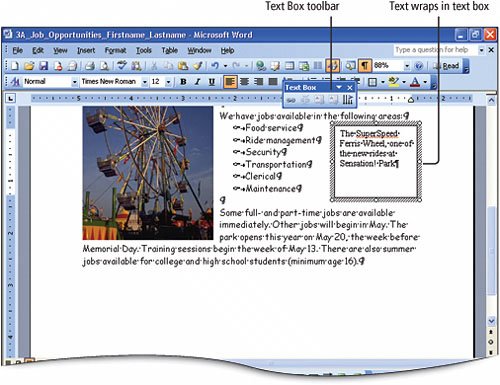
 displays. Drag the text box down to the empty area below the paragraph beginning Some full- and part-time. Recall that you can hold down
displays. Drag the text box down to the empty area below the paragraph beginning Some full- and part-time. Recall that you can hold down  and use the directional arrow keys to more precisely drive your object into position. Compare your screen with Figure 3.18.
and use the directional arrow keys to more precisely drive your object into position. Compare your screen with Figure 3.18. and then drag to the right to adjust the text box size until all the text in the box displays on three lines. Drag the lower center handle up to remove excess white space in the text box.
and then drag to the right to adjust the text box size until all the text in the box displays on three lines. Drag the lower center handle up to remove excess white space in the text box. to center the text within the text box, Save
to center the text within the text box, Save  , and then move your
, and then move your  before you drag to create the arrow or line.
before you drag to create the arrow or line. . Point to the Stars and Banners button
. Point to the Stars and Banners button  , and then compare your screen with Figure 3.22.
, and then compare your screen with Figure 3.22. and then move your
and then move your  , and then Center
, and then Center  . From the displayed color palette, in the fifth row, click the third colorLight Yellow. Click the Line Color arrow
. From the displayed color palette, in the fifth row, click the third colorLight Yellow. Click the Line Color arrow  , and then from the displayed color palette, in the second row, click the sixth colorBlue. Click outside the banner to deselect it, and then compare your screen with Figure 3.24.
, and then from the displayed color palette, in the second row, click the sixth colorBlue. Click outside the banner to deselect it, and then compare your screen with Figure 3.24. to check your document. Check your Chapter Assignment Sheet or Course Syllabus, or consult your instructor, to determine if you are to submit your assignments on paper or electronically using your college's course information management system. To submit electronically, go to Step 9, and then follow the instructions provided by your instructor.
to check your document. Check your Chapter Assignment Sheet or Course Syllabus, or consult your instructor, to determine if you are to submit your assignments on paper or electronically using your college's course information management system. To submit electronically, go to Step 9, and then follow the instructions provided by your instructor. .
.